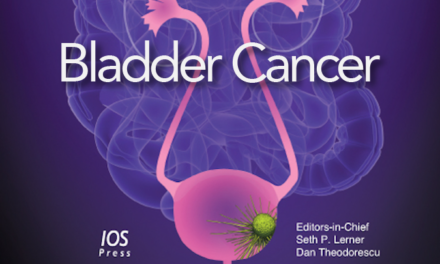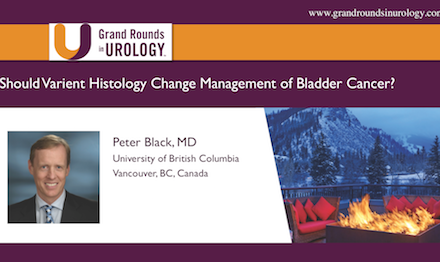Dr. Seth Lerner and Dr. Daniel Petrylak, both experts in the clinical area of bladder cancer, provide analysis of treating this common cancer and its future prospects.
Presentation:
In this issue of Grand Rounds in Urology, two leading experts in the clinical area of bladder cancer will provide analysis of treating this common cancer and its future prospects. According to recent statistics, bladder cancer is the fourth most common type of cancer in men and the eighth most common in women. Each year in the United States, more than 70,000 men and women combined are diagnosed with bladder cancer. More than 90% of patients with bladder cancer (both men and women) have a transitional cell cancer (TCC), and unfortunately current chemotherapeutic agents for advanced or metastatic disease rarely result in cure.. Additionally, bladder cancer is one of the most costly cancers to treat, more costly than lung cancer, more than breast cancer, and more costly than colon cancer. It is expected that the incidence of bladder cancer will continue to increase, and most of the surviving patients will require frequent follow up and treatment.
In the first article, Dr. Seth Lerner, from Baylor College of Medicine, discusses a number of challenges in managing localized disease , including intra- vesical therapy and endoscopic imaging. Since this field is moving fairly quickly, Dr. Lerner provides the reader with some tools that might answer the question as to why wouldn’t you want to see better at the time of cystoscopy. The discussion covers issues like fluorescence, narrow- band imaging, and optical coherence tomography as well as drug therapy, and we hope it will offer valuable ideas on how to provide a more complete diagno- sis and comprehensive therapy.
The second article is from Dr. Daniel Petrylak, from Columbia University, who provides his analysis a systemic approach to treatment. Of important emphasis is how understanding biology can help in the development of future clinical trials. Dan discusses adjuvant and neoadjuvant therapy, antiangiogentics agents, and the prospect of vaccines among the ongoing variety of approaches. His thorough review suggests there is an utmost need for collaborative clinical trials to find new ways to attack this difficult to treat and deadly disease.
Keywords: bladder cancer, localized disease, intra- vesical therapy, endoscopic imaging, cystoscopy, fluorescence, narrow-band imaging, optical coherence tomography, drug therapy, adjuvant therapy, neoadjuvant therapy, antiangiogentics agents, vaccines
How to cite: Lerner, Seth, and Daniel P. Petrylak. “Bladder Cancer: Advances in Diagnosis and Clinical Care.” Grand Rounds in Urology. January 19, 2015. Accessed Dec 2024. https://dev.grandroundsinurology.com/bladder-cancer-lerner-petrylak-diagnosis/.
References
1. American Cancer Society. Cancer Facts & Figures 2011. Atlanta: American Cancer Society; 2011.
2. Freedman ND, Silverman DT, Hollenbeck AR, Schatzkin A, Abnet CC. Association between smoking and risk of bladder cancer among men and women. JAMA. 2011;306:737-745. http://www.ncbi.nlm.nih.gov/pubmed/21846855
3. Witjes JA, Douglass J. The role of hexaminolevulinate fluorescence cystoscopy in bladder cancer. Nat Clin Pract Urol. 2007;4:542-549. http://www.ncbi.nlm.nih.gov/pubmed/17921969
4. Stenzl A, Burger M, Fradet Y, et al. Hexaminolevulinate guided fluorescence cystoscopy reduces recurrence in patients with nonmuscle invasive bladder cancer. J Urol. 2010;184:1907-1913. http://www.ncbi.nlm.nih.gov/pubmed/20850152
5. Lerner SP, Liu H, Wu MF, Thomas YK, Witjes JA. Fluorescence and white light cystoscopy for detection of carcinoma in situ of the urinary bladder. Urol Oncol. 2012 May-Jun;30(3):285-9. http://www.ncbi.nlm.nih.gov/pubmed/21396840
6. Witjes JA, Redorta JP, Jacqmin D, et al. Hexaminolevulinate-guided fluorescence cystoscopy in the diagnosis and follow-up of patients with nonmuscle-invasive bladder cancer: review of the evidence and recommendations. Eur Urol. 2010;57:607-614. http://www.ncbi.nlm.nih.gov/pubmed/20116164
7. Kausch I, Sommerauer M, Montorsi F, et al. Photodynamic diagnosis in non-muscle-invasive bladder cancer: a systematic review and cumulative analysis of prospective studies. Eur Urol. 2010;57:595-606. http://www.ncbi.nlm.nih.gov/pubmed/20004052
8. D’Hallewin MA, Kamuhabwa AR, Roskams T, De Witte PA, Baert L. Hypericin-based fluorescence diagnosis of bladder carcinoma. BJU Int. 2002;89:760-763. http://www.ncbi.nlm.nih.gov/pubmed/11966641
9. Sim HG, Lau WK, Olivo M, Tan PH, Cheng CW. Is photodynamic diagnosis using hypericin better than white-light cystoscopy for detecting superficial bladder carcinoma? BJU Int. 2005;95:1215-1218. http://www.ncbi.nlm.nih.gov/pubmed/15892804
10. Kubin A, Meissner P, Wierrani F, et al. Fluorescence diagnosis of bladder cancer with new water soluble hypericin bound to polyvinylpyrrolidone: PVP-hypericin. Photochem Photobiol. 2008;84:1560-1563. http://www.ncbi.nlm.nih.gov/pubmed/18627521
11. Naselli A, Puppo P. Narrow-band imaging—shifting the paradigm in the management of non-muscle-invasive bladder cancer? Expert Rev Anticancer Ther. 2012 Dec;12(12):1523-8. http://www.ncbi.nlm.nih.gov/pubmed/15892804
12. Bryan RT, Billingham LJ, Wallace DM. Narrow-band imaging flexible cystoscopy in the detection of recurrent urothelial cancer of the bladder. BJU Int. 2008;101:702-705. http://www.ncbi.nlm.nih.gov/pubmed/18005206
13. Herr HW, Donat SM. A comparison of white-light cystoscopy and narrow-band imaging cystoscopy to detect bladder tumour recurrences. BJU Int. 2008;102:1111-1114. http://www.ncbi.nlm.nih.gov/pubmed/18778359
14. Herr HW, Donat SM. Reduced bladder tumour recurrence rate associated with narrow-band imaging surveillance cystoscopy. BJU Int. 2011;107:396-398. http://www.ncbi.nlm.nih.gov/pubmed/20707789
15. Clinical Research Office of the Endourological Society (CROES). The Global Randomized NBI Bladder Cancer Study. Available at: http://www.croesoffice.org/OngoingProjects/NBIStudy.aspx (accessed 4 December 2011).
16. Goh AC, Tresser NJ, Shen SS, Lerner SP. Optical coherence tomography as an adjunct to white light cystoscopy for intravesical real-time imaging and staging of bladder cancer. Urology. 2008;72:133-137. http://www.ncbi.nlm.nih.gov/pubmed/18598789
17. Sanchez E, Goh A, Soni S, Lerner S. Optical coherence tomography (OCT) as an adjunct to conventional cystoscopy and pathology for non-invasive endoscopic staging of bladder tumors. Presented at the Société Internationale d’Urologie 2011 Annual Congress. October 16-20, 2011; Berlin, Germany. Abstract POD-05.06.
18. Schmidbauer J, Remzi M, Klatte T, et al. Fluorescence cystoscopy with high-resolution optical coherence tomography imaging as an adjunct reduces false-positive findings in the diagnosis of urothelial carcinoma of the bladder. Eur Urol. 2009;56:914-919.
19. Cauberg EC, de Bruin DM, Faber DJ, et al. Quantitative measurement of attenuation coefficients of bladder biopsies using optical coherence tomography for grading urothelial carcinoma of the bladder. J Biomed Opt. 2010;15:066013.
20. Lingley-Papadopoulos CA, Loew MH, Manyak MJ, Zara JM. Computer recognition of cancer in the urinary bladder using optical coherence tomography and texture analysis. J Biomed Opt. 2008;13:024003. http://www.ncbi.nlm.nih.gov/pubmed/18465966
21. Yuan Z, Luo ZC, Ren GH, Du CW, Pan Y. A digital frequency ramping method for enhancing Doppler flow imaging in Fourier-domain optical coherence tomography. Opt Express. 2009;17:3951-3963. http://www.ncbi.nlm.nih.gov/pubmed/19259236
22. Yuan Z, Chen B, Ren H, Pan Y. On the possibility of time-lapse ultrahigh-resolution optical coherence tomography for bladder cancer grading. J Biomed Opt. 2009;14:050502. http://www.ncbi.nlm.nih.gov/pubmed/19895098
23. Wu K, Liu JJ, Adams W, et al. Dynamic real-time microscopy of the urinary tract using confocal laser endomicroscopy. Urology. 2011;78:225-231. http://www.ncbi.nlm.nih.gov/pubmed/21601243
24. Oosterlinck W, Lobel B, Jakse G, et al. Guidelines on bladder cancer. Eur Urol. 2002;41:105-112. http://www.ncbi.nlm.nih.gov/pubmed/12074395
25. Sylvester RJ, Oosterlinck W, van der Meijden AP. A single immediate postoperative instillation of chemotherapy decreases the risk of recurrence in patients with stage Ta T1 bladder cancer: a meta-analysis of published results of randomized clinical trials. J Urol. 2004;171:2186-2190. http://www.ncbi.nlm.nih.gov/pubmed/15126782
26. Madeb R, Golijanin D, Noyes K, et al. Treatment of nonmuscle invading bladder cancer: do physicians in the United States practice evidence based medicine? The use and economic implications of intravesical chemotherapy after transurethral resection of bladder tumors. Cancer. 2009;115:2660-2670. http://www.ncbi.nlm.nih.gov/pubmed/19455607
27. Lamm DL, McGee WR, Hale K. Bladder cancer: current optimal intravesical treatment. Urol Nurs. 2005;25:323-326, 331-322. http://www.ncbi.nlm.nih.gov/pubmed/16294610
28. Di Stasi SM, Verri C, Capelli G, et al. Single preoperative intravesical instillation of electromotive mitomycin-C for primary non-muscle-invasive bladder cancer: A prospective randomized trial. J Clin Oncol. 2011;28(15S): Abstract 4543.
29. Di Stasi SM, Giannantoni A, Giurioli A, et al. Sequential BCG and electromotive mitomycin versus BCG alone for high-risk superficial bladder cancer: a randomised controlled trial. Lancet Oncol. 2006;7:43-51. http://www.ncbi.nlm.nih.gov/pubmed/16389183
30. Southwest Oncology Group. Gemcitabine after surgery in treating patients with newly diagnosed or recurrent bladder cancer. Available at: http://clinicaltrials.gov/ct2/show/NCT00445601 (accessed 4 December 2011).
31. van der Heijden AG, Moonen PM, Cornel EB, et al. Phase II marker lesion study with intravesical instillation of apaziquone for superficial bladder cancer: toxicity and marker response. J Urol. 2006;176:1349-1353. http://www.ncbi.nlm.nih.gov/pubmed/16952629
32. Spectrum Pharmaceuticals, Inc. Efficacy and safety of multi-instillations of apaziquone in patients with non-muscle invasive bladder cancer. Available at: http://clinicaltrials.gov/ct2/show/NCT01410565 (accessed 4 December 2011).
33. Spectrum Pharmaceuticals, Inc. Efficacy and safety study of apaziquone vs. placebo in patients with non-muscle invasive bladder cancer (NMIBC). Available at: http://clinicaltrials.gov/ct2/show/NCT01469221 (accessed 4 December 2011).
34. Spectrum Pharmaceuticals, Inc. Phase 3 trial of single-dose intravesical EOquin® as a surgical adjuvant for noninvasive bladder cancer. Available at: http://clinicaltrials.gov/ct2/show/NCT00598806 (accessed 4 December 2011).
35. Porter PL, Sage EH, Lane TF, Funk SE, Gown AM. Distribution of SPARC in normal and neoplastic human tissue. J Histochem Cytochem. 1995;43:791-800. http://www.ncbi.nlm.nih.gov/pubmed/7622842
36. Yamanaka M, Kanda K, Li NC, et al. Analysis of the gene expression of SPARC and its prognostic value for bladder cancer. J Urol. 2001;166:2495-2499. http://www.ncbi.nlm.nih.gov/pubmed/11696817
37. McKiernan JM, Barlow LJ, Laudano MA, Mann MJ, Petrylak DP, Benson MC. A phase I trial of intravesical nanoparticle albumin-bound paclitaxel in the treatment of bacillus Calmette-Guérin refractory nonmuscle invasive bladder cancer. J Urol. 2011;186:448-451. http://www.ncbi.nlm.nih.gov/pubmed/21680003
38. Southwest Oncology Group. Standard or extended pelvic lymphadenectomy in treating patients undergoing surgery for invasive bladder cancer. Available at: http://clinicaltrials.gov/ct2/show/NCT01224665 (accessed 4 December 2011).
39. Saxman SB, Propert KJ, Einhorn LH, et al. Long-term follow-up of a phase III intergroup study of cisplatin alone or in combination with methotrexate, vinblastine, and doxorubicin in patients with metastatic urothelial carcinoma: a cooperative group study. J Clin Oncol. 1997;15:2564-2569. http://www.ncbi.nlm.nih.gov/pubmed/9215826
40. Sternberg CN, de Mulder PH, Schornagel JH, et al. Randomized phase III trial of high-dose-intensity methotrexate, vinblastine, doxorubicin, and cisplatin (MVAC) chemotherapy and recombinant human granulocyte colony-stimulating factor versus classic MVAC in advanced urothelial tract tumors: European Organization for Research and Treatment of Cancer Protocol no. 30924. J Clin Oncol. 2001;19:2638-2646. http://www.ncbi.nlm.nih.gov/pubmed/11352955
41. von der Maase H, Hansen SW, Roberts JT, et al. Gemcitabine and cisplatin versus methotrexate, vinblastine, doxorubicin, and cisplatin in advanced or metastatic bladder cancer: results of a large, randomized, multinational, multicenter, phase III study. J Clin Oncol. 2000;18:3068-3077. http://www.ncbi.nlm.nih.gov/pubmed/11001674
42. von der Maase H, Sengelov L, Roberts JT, et al. Long-term survival results of a randomized trial comparing gemcitabine plus cisplatin, with methotrexate, vinblastine, doxorubicin, plus cisplatin in patients with bladder cancer. J Clin Oncol. 2005;23:4602-4608. http://www.ncbi.nlm.nih.gov/pubmed/16034041
43. Bellmunt J, von der Maase H, Mead GM, et al. Randomized phase III study comparing paclitaxel/cisplatin/gemcitabine (PCG) and gemcitabine/cisplatin (GC) in patients with locally advanced (LA) or metastatic (M) urothelial cancer without prior systemic therapy; EORTC30987/Intergroup Study. J Clin Oncol. 2007;25(18S): Abstract LBA5030.
44. Inoue K, Slaton JW, Perrotte P, et al. Paclitaxel enhances the effects of the anti-epidermal growth factor receptor monoclonal antibody ImClone C225 in mice with metastatic human bladder transitional cell carcinoma. Clin Cancer Res. 2000;6:4874-4884. http://www.ncbi.nlm.nih.gov/pubmed/11156247
45. Hahn NM, Stadler WM, Zon RT, et al. A multicenter phase II study of cisplatin (C), gemcitabine (G), and bevacizumab (B) as first-line chemotherapy for metastatic urothelial carcinoma (UC): Hoosier Oncology Group GU-0475. J Clin Oncol. 2009;27(15S): Abstract 5018.
46. Hahn NM, Stadler WM, Zon RT, et al. Phase II trial of cisplatin, gemcitabine, and bevacizumab as first-line therapy for metastatic urothelial carcinoma: Hoosier Oncology Group GU 04-75. J Clin Oncol. 2011;29:1525-1530. http://www.ncbi.nlm.nih.gov/pubmed/21422406
47. Bellmunt J, González-Larriba JL, Prior C, et al. Phase II study of sunitinib as first-line treatment of urothelial cancer patients ineligible to receive cisplatin-based chemotherapy: baseline interleukin-8 and tumor contrast enhancement as potential predictive factors of activity. Ann Oncol. 2011;22:2646-2653. http://www.ncbi.nlm.nih.gov/pubmed/21427062
48. Gallagher DJ, Milowsky MI, Gerst SR, et al. Phase II study of sunitinib in patients with metastatic urothelial cancer. J Clin Oncol. 2010;28:1373-1379. http://www.ncbi.nlm.nih.gov/pubmed/20142593
49. University of Michigan Cancer Center. Trial of maintenance SUO11248 versus placebo post chemotherapy for patients with advanced urothelial carcinoma. Available at: http://clinicaltrials.gov/ct2/show/NCT00393796 (accessed 4 December 2011).
50. Sridhar SS, Winquist E, Eisen A, et al. A phase II trial of sorafenib in first-line metastatic urothelial cancer: a study of the PMH Phase II Consortium. Invest New Drugs. 2011;29:1045-1049. http://www.ncbi.nlm.nih.gov/pubmed/20191303
51. Dreicer R, Li H, Stein M, et al. Phase 2 trial of sorafenib in patients with advanced urothelial cancer: a trial of the Eastern Cooperative Oncology Group. Cancer. 2009;115:4090-4095. http://www.ncbi.nlm.nih.gov/pubmed/19536901
52. Sweeney CJ, Roth BJ, Kabbinavar FF, et al. Phase II study of pemetrexed for second-line treatment of transitional cell cancer of the urothelium. J Clin Oncol. 2006;24:3451-3457. http://www.ncbi.nlm.nih.gov/pubmed/16849761
53. Kruczynski A, Hill BT. Vinflunine, the latest Vinca alkaloid in clinical development. A review of its preclinical anticancer properties. Crit Rev Oncol Hematol. 2001;40:159-173. http://www.ncbi.nlm.nih.gov/pubmed/11682323
54. Bellmunt J, Théodore C, Demkov T, et al. Phase III trial of vinflunine plus best supportive care compared with best supportive care alone after a platinum-containing regimen in patients with advanced transitional cell carcinoma of the urothelial tract. J Clin Oncol. 2009;27:4454-4461. http://www.ncbi.nlm.nih.gov/pubmed/19687335
55. Choueiri TK, Vaishampayan UN, Yu EY, et al. A double-blind randomized trial of docetaxel plus vandetanib versus docetaxel plus placebo in platinum-pretreated advanced urothelial cancer. J Clin Oncol. 2011;29(suppl 7): Abstract LBA239. http://www.ncbi.nlm.nih.gov/pubmed/22184381
56. ImClone LLC. Study of ramucirumab or IMC-18F1 with docetaxel or docetaxel alone as second-line therapy in participants with bladder, urethra, ureter, or renal pelvis carcinoma. Available at: http://clinicaltrials.gov/ct2/show/NCT01282463 (accessed 4 December 2011).
57. Jichlinski P, Guillou L, Karlsen SJ, et al. Hexyl aminolevulinate fluorescence cystoscopy: a new diagnostic tool for photodiagnosis of superficial bladder cancer—a multicenter study. J Urol. 2003;170:226-229. http://www.ncbi.nlm.nih.gov/pubmed/12796694
58. Schmidbauer J, Witjes F, Schmeller N, et al. Improved detection of urothelial carcinoma in situ with hexaminolevulinate fluorescence cystoscopy. J Urol. 2004;171:135-138. http://www.ncbi.nlm.nih.gov/pubmed/14665861
59. Jocham D, Witjes F, Wagner S, et al. Improved detection and treatment of bladder cancer using hexaminolevulinate imaging: a prospective, phase III multicenter study. J Urol. 2005;174:862-866. http://www.ncbi.nlm.nih.gov/pubmed/16093971
60. Fradet Y, Grossman HB, Gomella L, et al. A comparison of hexaminolevulinate fluorescence cystoscopy and white light cystoscopy for the detection of carcinoma in situ in patients with bladder cancer: a phase III, multicenter study. J Urol. 2007;178:68-73. http://www.ncbi.nlm.nih.gov/pubmed/17499291
61. Grossman HB, Gomella L, Fradet Y, et al. A phase III, multicenter comparison of hexaminolevulinate fluorescence cystoscopy and white light cystoscopy for the detection of superficial papillary lesions in patients with bladder cancer. J Urol. 2007;178:62-67. http://www.ncbi.nlm.nih.gov/pubmed/17499283
ABOUT THE AUTHOR
Seth P. Lerner, MD, is a Professor of Urology and holds the Beth and Dave Swalm Chair in Urologic Oncology in the Scott Department of Urology at Baylor College of Medicine. He is also Director of Urologic Oncology and the Multidisciplinary Bladder Cancer Program and Faculty Group Practice Medical Director for the Urology Clinic at Baylor. He earned his medical degree from Baylor College of Medicine, completed a surgical internship at Virginia Mason Hospital in Seattle, and returned to Baylor for his residency training. He completed a two-year fellowship at the University of Southern California in Urologic Oncology and Reconstructive Surgery under Peter Jones and Don Skinner before returning to join the full-time Baylor faculty in 1992. His clinical practice, education, and research activities are devoted to urologic oncology, particularly lower and upper tract urothelial cancer. Dr. Lerner is an author on over 190 peer-reviewed articles, and co-editor of the comprehensive Textbook of Bladder Cancer. He is the founding Co-Editor-in-Chief of the Bladder Cancer journal. He established and directs the multi-disciplinary Bladder Cancer Research Program at Baylor, and his research interests include the use of selective estrogen receptor modulators for the treatment of bladder cancer, gene therapy, integrated genomic analysis of bladder and upper urinary tract cancers, and outcomes of radical cystectomy and pelvic lymphadenectomy. He has 25 years of experience as a clinical investigator for both NCI and industry-funded clinical trials. He is the PI of the ongoing SWOG NCI Phase III trial comparing extended vs. standard pelvic lymphadenectomy at the time of radical cystectomy. He is Chair of the Local Bladder Cancer Committee of SWOG, founding and former Co-Chair of the NCI Bladder Cancer Task Force and current Co-Chair of the NCI CTEP Genitourinary Steering Committee, and he has co-chaired the Analysis Working Group of The Cancer Genome Atlas Project for muscle-invasive bladder cancer for the past decade. He is very active in the Bladder Cancer Advocacy Network (BCAN) as a member of the Board of Directors, and is Past Chair of the Bladder Cancer Think Tank and Co-Chair of the Management Committee of the Bladder Cancer Research Network. Dr. Lerner is an active member of the prestigious American Association of Genitourinary Surgeons and is listed routinely among “America’s Top Doctors” and “Best Doctors in America.”





